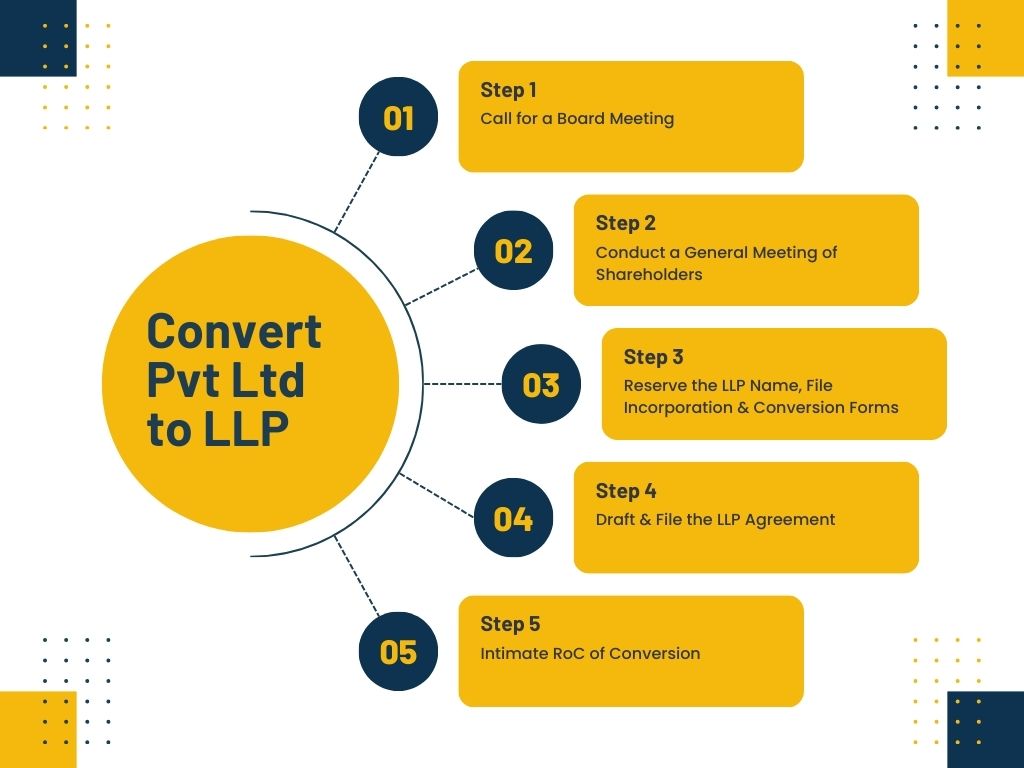Learn how to convert Pvt Ltd Company to LLP with this step-by-step guide

Thinking about converting your Private Limited Company to an LLP? You're not alone—many Indian businesses are making this strategic shift to take advantage of the LLP model's tax efficiency and flexible structure. From small IT consulting firms in Bengaluru to chartered accountancy practices in Mumbai, entrepreneurs across India are discovering that Limited Liability Partnerships offer a perfect middle ground between the compliance rigor of companies and the operational flexibility of partnerships.
However, converting your Private Limited Company into an LLP isn't as simple as filing a single form. The process requires careful navigation through multiple legal steps, government filings, and stakeholder consents. One misstep can lead to delays, penalties, or even rejection of your application.
This comprehensive guide outlines the complete procedure for conversion of a Private Limited Company into LLP, including all the required forms, legal requirements, realistic timelines, and practical advice that business owners in India need to make this transition smoothly and efficiently.
Lower compliance burden – Private Limited Companies must file annual returns, board meeting minutes, and maintain extensive statutory registers, LLPs have significantly reduced paperwork requirements.
Dividend distribution tax - In a Private Limited Company, profits distributed to shareholders are subject to additional taxation, but LLP partners can withdraw their share of profits without this extra tax burden.
Flexible ownership structure - Unlike Private Limited Companies with rigid share capital requirements, LLPs can easily modify profit-sharing ratios, add new partners, or restructure ownership without complex legal procedures.
The decision to convert becomes compelling in several scenarios. If you're finding ROC compliance increasingly burdensome for your small-scale operations, an LLP structure can reduce your regulatory overhead significantly.
Small-scale operations with liability concerns are ideal candidates for conversion.
If you're seeking simplified taxation and profit-sharing models, LLP conversion makes excellent business sense.
The legal foundation for company-to-LLP conversion lies in Section 56 of the LLP Act, 2008 along with Schedule II, which provides the detailed framework for this transformation. This provision specifically allows existing companies to convert itself into Limited Liability Partnership (LLP) provided they meet certain eligibility criteria.
The most important restriction is that the company must be unlisted with no security interest created on its assets in favor of banks or financial institutions. This means if your company has taken secured loans against its assets, you'll need to either clear these loans or obtain written consent from lenders before proceeding with conversion.

The conversion journey begins with a formal meeting of Board of Directors of the company. You need to document the board's intent to convert, authorize a specific director to act on the company's behalf throughout the process, and prepare a comprehensive draft resolution for the upcoming Extraordinary General Meeting (EGM).
The board resolution should clearly state the rationale for conversion, identify the proposed designated partners for the new LLP, and authorize all necessary actions for completing the conversion process. This resolution becomes a crucial document that you'll need to attach with various forms throughout the conversion process.
100% shareholder consent for the conversion. Unlike many corporate decisions that require simple or special majority, LLP conversion demands unanimous agreement from all shareholders. This means even a single dissenting shareholder can block the entire conversion process.
The Extraordinary General Meeting must pass a special resolution for conversion with detailed terms of how existing shares will be converted to partnership interests, how the profit-sharing will work in the new LLP structure, and what happens to existing rights and obligations.
Secure a unique name for your LLP through RUN-LLP (Reserve Unique Name) application. This step is crucial because name availability isn't guaranteed, and you might need multiple attempts to find an acceptable name.
Attach your Board Resolution and the object clause of your proposed LLP with this application. The Registrar typically takes 3-7 working days to approve or reject the name. Pro tip: have 2-3 backup names ready because your first choice might already be taken or might not meet the naming guidelines.
This is the most complex step involving two critical forms that must be filed simultaneously:
Form FiLLiP (Form for LLP Incorporation) requires you to appoint designated partners (minimum 2 required), attach their ID and address proofs, obtain their consent through Form 9, and prepare a subscribers' sheet. Each designated partner must have a Digital Signature Certificate (DSC) and Director Identification Number (DIN) if they were directors in the original company.
E-Form 18 is required to be filed as the official application for conversion. This comprehensive form must include a detailed statement of all shareholders, their written consent to convert, certified copies of Certificate of Incorporation (COI), Memorandum of Association (MOA), Articles of Association (AOA), copies of board and shareholder resolutions, and consent from all shareholders. The form also requires details of the company's assets, liabilities, and proposed LLP agreement.
Once you've successfully filed Form 18 and FiLLiP with all supporting documents, the Registrar of Companies (RoC) will review your application. If everything is in order, they'll issue the Certificate of Registration which officially brings your LLP into existence and simultaneously dissolves the Private Limited Company.
The review process typically takes 15-30 working days, but this can extend if the RoC raises queries or requires additional documentation. During this period, your company continues to operate normally until the conversion is complete.
Within 30 days of receiving your Certificate of Registration, you must file e-Form 3 containing your comprehensive LLP Agreement. This document is the cornerstone of your new business structure, defining partnership rules, individual rights and responsibilities, capital contribution requirements, profit-sharing mechanisms, and procedures for adding or removing partners.
The LLP Agreement should be drafted carefully because amendments later require consent from all partners and formal filing with the RoC. Many businesses benefit from professional legal assistance at this stage to ensure all contingencies are covered.
The final step requires filing e-Form 14 within 15 days of receiving your Certificate of Registration. This intimation formally notifies the RoC that the conversion has been completed and provides details of the new LLP structure.
The documents required to convert your Pvt Ltd Company into an LLP form an extensive checklist that requires careful preparation:
Corporate Documents: Board Resolution approving conversion, Special Resolution from shareholders' meeting, certified copies of MOA and AOA, Certificate of Incorporation, and any amendments to these documents.
Shareholder Documentation: Detailed statement of all shareholders with their shareholding percentages, written consent from each shareholder for the conversion, and proof of 100% shareholder agreement.
Partner Documentation: PAN cards, Aadhaar cards, and address proof for all proposed designated partners, Form 9 (consent to act as designated partner) from each partner, and Digital Signature Certificates for online filing.
Financial Documents: Latest audited financial statements, statement of assets and liabilities, and details of any charges or security interests on company assets.
Compliance Documents: NOC from creditors (if applicable), clearance certificates from tax authorities, and any other regulatory clearances specific to your business sector.
Consider the case of a small IT consulting firm based in Pune with three equal shareholders who were also the only directors. The company was generating annual revenue of ₹50 lakhs but was finding company compliance increasingly burdensome for their small team.
Timeline: The conversion process took 35-50 days from the initial board meeting to receiving the Certificate of Registration. The longest delay was in obtaining unanimous shareholder consent and preparing all required documentation.
Costs: The total cost came to approximately ₹25k - 75K, including government fees (₹1,000 for name reservation, ₹500 for FiLLiP, ₹5,000 for Form 18), professional fees (₹20k - 50K), stamp duty (₹2,000), and miscellaneous costs for notarization and documentation (₹1,500).
Outcome: Post-conversion, LLP reduced their annual compliance costs by 60%, eliminated the need for formal board meetings, and gained flexibility in profit distribution among partners. The simplified structure allowed them to focus more on business growth rather than regulatory compliance.
Incomplete Documentation is the most frequent cause of application rejection. Ensure all forms are completely filled, all supporting documents are properly certified, and there are no discrepancies in names, addresses, or other details across different documents.
Poor Communication Management can create problems post-conversion. Many businesses forget to inform banks, vendors, customers, and service providers about the change in business structure, leading to confusion in transactions and communications.
Delayed License Updates can result in compliance issues. Update your PAN, GST registration, professional licenses, and bank account details immediately after conversion to avoid any disruption in business operations.
Missing Critical Deadlines can invalidate your conversion. The LLP Agreement must be filed within 30 days, and intimation to RoC must be done within 15 days of receiving the Certificate of Registration. Missing these deadlines can result in penalties and compliance issues.
Can a private limited company be converted to LLP? Yes, any unlisted private limited company with no security interest on its assets can convert to LLP under Section 56 of the LLP Act, 2008.
How much does it cost to convert Pvt Ltd to LLP in India? The total cost typically ranges from ₹25,000 to ₹75,000, including government fees, professional charges, and documentation costs.
What is Form 18 for LLP conversion? Form 18 is the official application form for converting a company into LLP, containing details of shareholders, assets, liabilities, and consent for conversion.
What are the tax implications of converting to LLP? LLPs enjoy pass-through taxation where the LLP pays minimal tax and partners are taxed individually on their profit share, often resulting in tax savings.
How long does it take to convert a Private Limited Company to an LLP? The complete process typically takes 30-45 days, depending on documentation readiness and RoC processing time.
Converting your Private Limited Company to LLP represents a strategic decision that can significantly reduce your compliance burden while maintaining limited liability protection. The key to successful conversion lies in following the step-by-step legal procedure meticulously, filing all correct forms with complete documentation, and obtaining all necessary approvals without rushing the process.
The benefits – reduced compliance costs, simplified taxation, operational flexibility, and streamlined profit distribution – make this conversion particularly attractive for small to medium enterprises and professional service providers. However, the process requires attention to detail and adherence to strict timelines.
Professional guidance can save time, money, and prevent costly mistakes that could delay or derail your conversion process. The investment in expert assistance often pays for itself through faster processing and avoided complications.
Ready to convert your Private Limited Company to LLP? Our experienced compliance advisors specialize in seamless business structure transitions. We handle everything from initial documentation to final certificate receipt, ensuring your conversion is completed efficiently and correctly. Contact us today for a free consultation and discover how we can make your conversion process smooth and hassle-free.
This article is for informational purposes only and should not be considered as legal or tax advice. Always consult with qualified professionals before making business structure decisions.